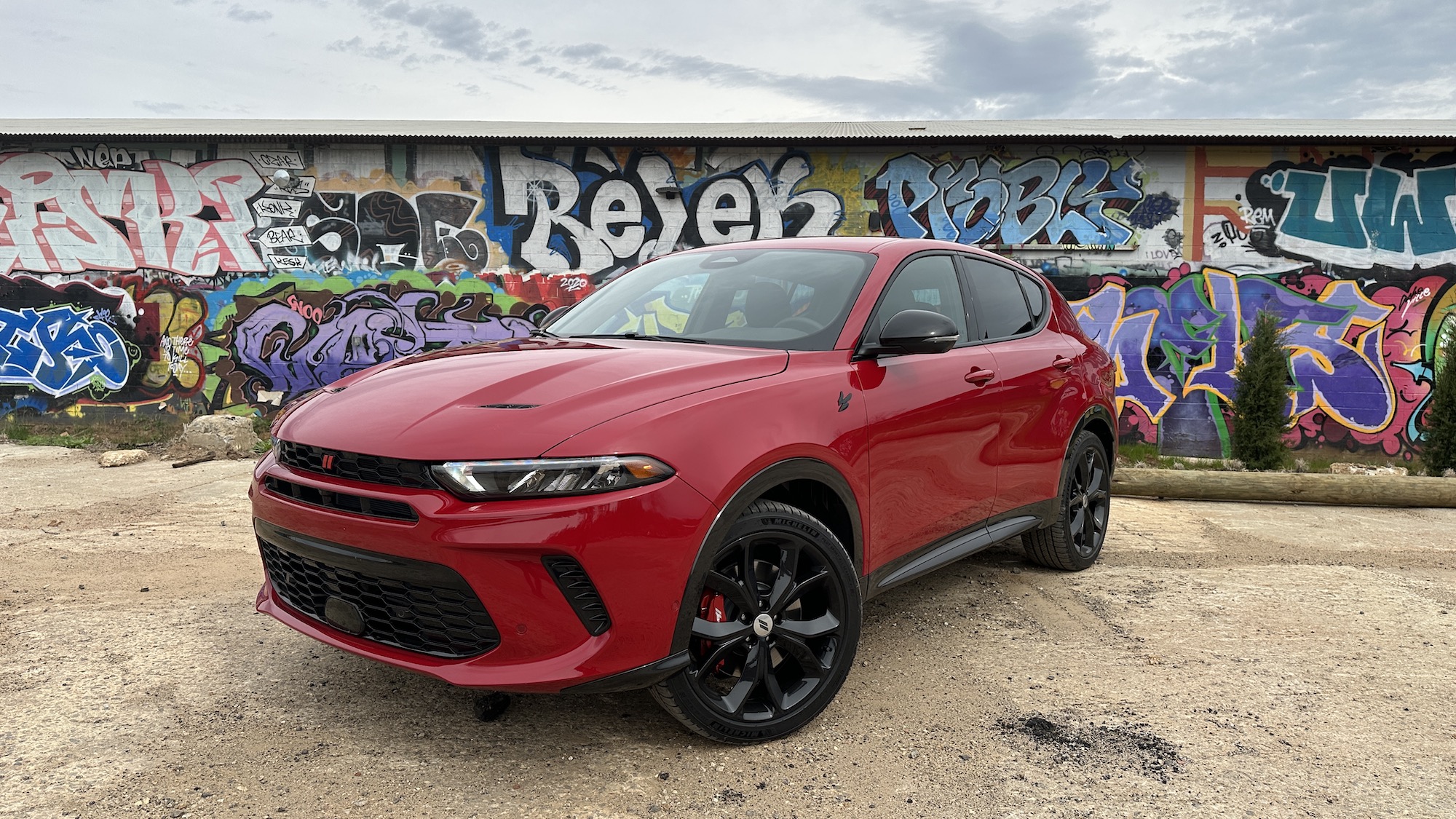

The Dodge brand leans heavily into performance, with commercials talking about “the brotherhood of muscle” and cars with names like “Demon” and “Hellcat.” So it’s no surprise that when releasing its first electrified vehicle, Dodge came up with a crossover to meet the market demand for family-friendly vehicles that includes a concession to in-your-face swagger. The new vehicle is called the Hornet, and it’s available in both a gas-only (GT) and a plug-in hybrid version (R/T).
Chris Piscitelli, one of the designers of the all-new Hornet, says the vehicle’s stinging-insect namesake is “a nasty little thing.” He says that with a mischievous grin, clearly happy with the association; the five-seater exudes intentional personality. In both drive and looks, the Hornet exhibits the Dodge legacy in the form of a small SUV that feels more like a hot hatch than a family car.
The Hornet R/T (that stands for road/track) offers a unique feature called PowerShot. When the driver chooses Sport mode and pulls both paddle shifters (for changing gears in manual mode) simultaneously, the system tacks on a bonus 30 horsepower. Then, stepping on the accelerator and mashing it down through a palpable click triggers a mechanism called a detent that tells the car to get moving. Pronto.

Dodge’s first electrified vehicle
This is Dodge’s first foray into electrification, and the brand is not taking any chances with its reputation. In its base iteration, the Hornet G/T is propelled by a 2.0-liter turbocharged inline four-cylinder engine that Dodge labeled the Hurricane4. As a plug-in hybrid, the Hornet R/T combines a turbo four-cylinder 1.3-liter engine and a single electric motor mounted to the rear axle, and together it’s good for 288 horsepower and 383 pound-feet of torque. During the presentation, Dodge representatives said the Hornet’s closest competitor is the Mazda CX-5, which gets 256 horsepower and 320 pound-feet of torque.
Dodge vehicle synthesis senior manager Brian Del Pup has worked with the automotive companies under the Stellantis umbrella (including Dodge and Chrysler) for the last two decades or so. He says the team pushed the Hornet to be as true to the brand as possible, stretching the limits of what a typical crossover—like a Subaru Outback or a Honda HR-V—might be.
“A lot of [crossovers] are appliances, and people buy them to get from point A to point B and that’s it,” Del Pup tells PopSci. “There’s a lot of things that we did with this vehicle to make it fun and make it stick out. It’s a plug-in hybrid, but that wasn’t the focus. The focus was, ‘Hey, how much performance can we get out of this architecture?’ And ‘How can we make it perform like a sports car?’ It had to feel and drive like a Dodge.”
Part of that vision included the PowerShot for the Hornet PHEV, complete with the detent that requires mashing the pedal to the floor. Other vehicles use that type of tactile click to indicate the pedal is near the end of travel, and it announces the initiation of a more aggressive maneuver.
During testing, Del Pup was sitting in the passenger seat and encouraged me to press the accelerator more firmly until I could feel it; soon we were traveling at a much higher rate of speed as though we were experiencing a tiny wrinkle in time.

Boosting the power, 15 seconds at a time
In the Hornet R/T, a PowerShot activation shaves 1.5 seconds from the 0-to-60 time for a total of 5.6 seconds from a dead stop. That said, the feature doesn’t offer a never-ending buffet of power boosts. Depending on the battery health and state of charge, the actual boost will vary, and it lasts for about 15 seconds.
“[PowerShot works best] at a higher state of charge and when the battery is at temperatures that high-voltage batteries like, which is around 72 degrees,” Del Pup explains. “When you deviate from that, it will still allow a PowerShot, but it may take some away based on where the system is.”
It also requires a 15-second cooldown period between activations. Unlike a video game, however, it doesn’t limit the total number of PowerShots per drive.
Plugging the Hornet R/T into a Level 2 charger fills up the battery in about 2.5 hours, Dodge says. The 15.5-kilowatt-hour battery pack is capable of 30 miles of all-electric driving under ideal conditions, which is about three miles short of the average American commute (according to AAA). The EPA hasn’t released fuel economy numbers for the R/T, but we expect those to beat the 21 miles per gallon city/29 miles per gallon highway numbers from the Hornet GT.
